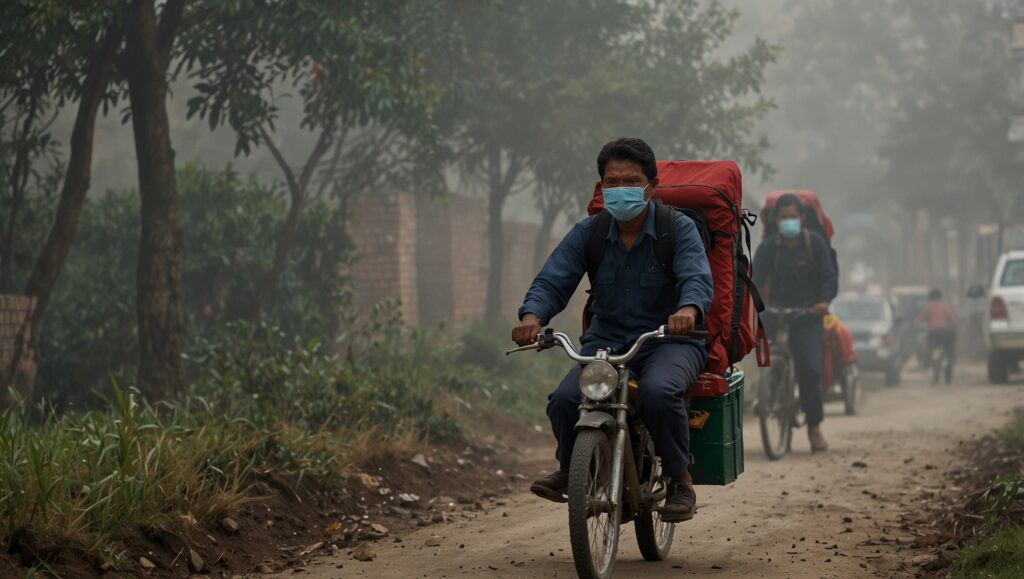There is an alarming deterioration of the air quality in Nepal, as road emissions and construction dust are becoming primary causes to blame for the decline of the country’s atmosphere. Kathmandu, the capital city of the country, which used to be famous for fresh mountain air, often gets blanketed with pollution. This was seen throughout the year 2024, and thus, there were many campaigns by environmentalists, medical practitioners, and other persons concerned about the rate at which forests are being cut down.
Urbanization, coupled with the development of infrastructure, which the country has gone through in the recent past, has taken its toll on the environment. There has been a dramatic rise in vehicle traffic, especially in populated areas, which has raised significant emissions of fumes. This is made worse by the geographical structure of Kathmandu Valley – a depression that retains both water and pollutants, thus resulting in smog, especially during winter when there are temperature inversions.
Despite being critical for development, construction activities nationwide are turning into potent emission points of particulate matter. Poor waste management practices, combined with the dust arising from construction sites, have greatly influenced poor air quality. Dust in most construction works is not well managed, and fine dust is often dispersed to large spaces.
The consequences of this air quality emergency are numerous and adversely affect the health of people. Doctors say that they have documented an increase in respiratory diseases, particularly among children and the elderly. Asthma, bronchitis, and other respiratory disorders have also intensified, not sparing Nepal’s health system from a new load. The use of fossil fuels, emissions from vehicles and industries, and air pollution have long-term health impacts, which are now worrying health professionals.
Criticism has been strong from environmental activists and NGOs over this issue that concerns the government’s response to air quality conditions. They say that while there were written policies for the implementation and enforcement of policies, these have not been well done. The increase in noise over the same has led to increased demands for higher and better standards of vehicle emissions, improved industrial emissions control, and enhanced dust control in construction sites.
This sector, again, is a major contributor to Nepal’s economy, and the effects of deteriorating air quality are also borne by it. This particular reason for the scenic beauty and mountain ravishing appeals of the country has been partially or fully hidden behind the smog and haze. A survey among the tour operators indicates that their clients are becoming more sensitive to air quality, which is a threat to the viability of this crucial economic sub-sector.
There are several measures revealed by the government as the response to pressure concerning the air quality problem. Among these are the strategies of changing the least Eco-friendly vehicles in use, putting into practice the greening of cities by encouraging planted areas in urban settings, and strict measures on environmental standards on buildings and industries. However, critics say that the government is doing this just in part, which is a measure in the right direction but not a comprehensive measure towards addressing the problem.
Specific urban centers and municipalities have been proactively putting into practice exceptional standards of measures against airborne pollutants. These are pedestrian-only areas, tree-planting drives, and public participation crusades on environmental issues such as poor air quality. However, such initiatives have been widely appreciated, and various specialists underline how important it is to synchronize measures and aim to implement inter-branch and national initiatives to combat the fundamental causes of air pollution.
The air quality crisis in Nepal provides a painful illustration of environmental issues that developing countries are experiencing as they try to attain economic growth. Mitigating developmental requirements with environmental conservation is not an easy affair, but it is one of the most fundamental tasks that have to be accomplished in any given society for the improvement of the welfare of its people. As this challenge engages Nepal, the future months and years will be definitive in figuring out whether the country will be able to reverse the trend of deterioration of air quality.


